Cherry barbus: description, maintenance and care
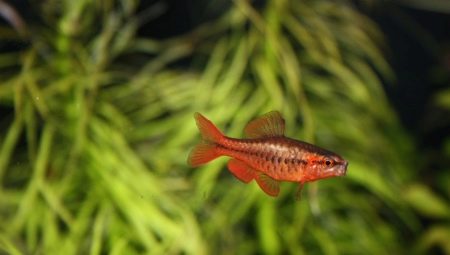
The cherry barb or puntius is an ornamental aquarium fish, belongs to the carp family, is distinguished by its modest size and peaceful character. These small bright pets thrive best in a flock of 6-8 individuals and generally have good compatibility with other fish. Breeding them at home in an aquarium is also not difficult, but you need to remember that the female needs special conditions for spawning.
The maintenance and care of a cherry veil barbus is not difficult - it is enough to provide space for swimming, plant plants and arrange decorations. Such a pet, including those with ordinary fins without decorative features, is well suited for novice aquarists. Making a mistake, somehow harming the fish is quite difficult. She tolerates a temporary drop in temperature well, can eat ready-made feed. The only thing that will have to be given special attention is the purity of the aquatic environment.
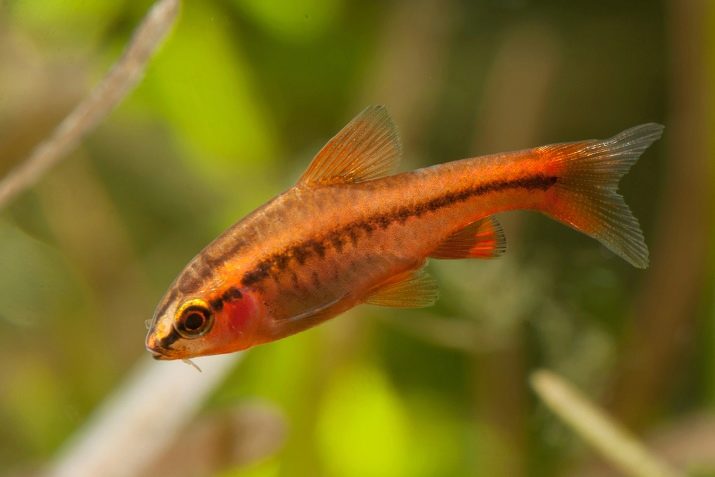
Description
Veil or cherry barb is a compact fish that naturally lives in Sri Lanka, in the valleys of small shallow rivers. The habitat of this puntius species is silty, rich in plants, with warm water. The owner will have to create similar conditions in the aquarium, providing the fish with opportunities for hide and seek and active swimming.
The miniature size - from 2.5 to 5 cm - allows you to make rather modest requirements for choosing a place of residence for a cherry barbus. It easily adapts even to a small home aquarium, you just have to install the lid - the fish are quite jumpy, they can easily leave the tank.
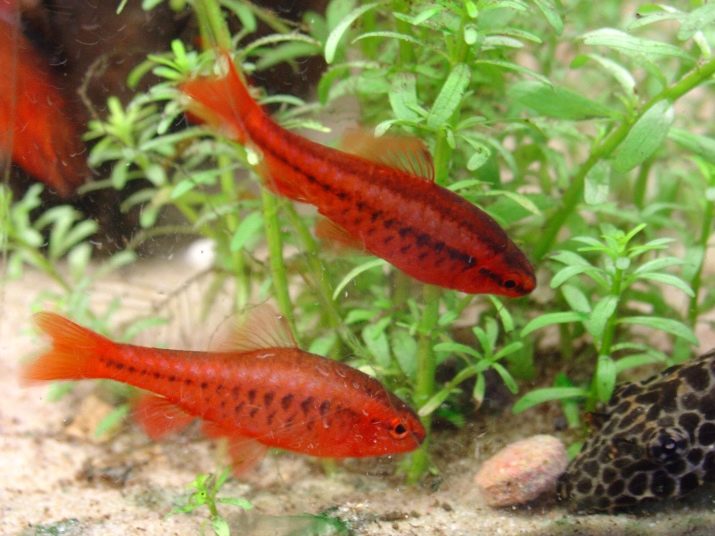
A distinctive feature of the cherry barb is the presence of a bright color in males, it becomes especially intense during the spawning period.
It is characteristic that the fish in nature have an even richer color, and their aquarium counterparts are noticeably paler. Females look especially faded, but this factor significantly facilitates the selection of pets by gender. In captivity, the brightness of the color also largely depends on the quality of nutrition, the regularity of replacing the young.
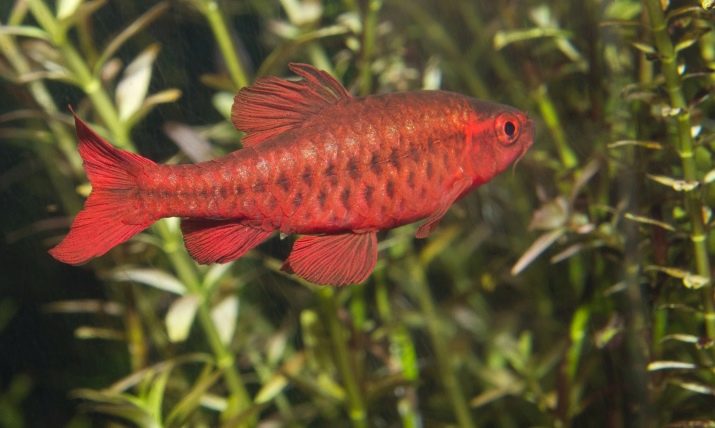
The body shape of the cherry barbus is typical for all fish of this species and resembles a torpedo. The fins are small, translucent, the tail is bifurcated, on the body there is a horizontal discontinuous strip running from the nose, on the muzzle there is a small mustache. The veil variety has elongated, spectacularly fluttering fins.
Puntius cherry color can hardly be called a long-liver. The average age of the fish is from 3 to 4 years; under good conditions of keeping, it is possible to increase these indicators by another 1-2 years.
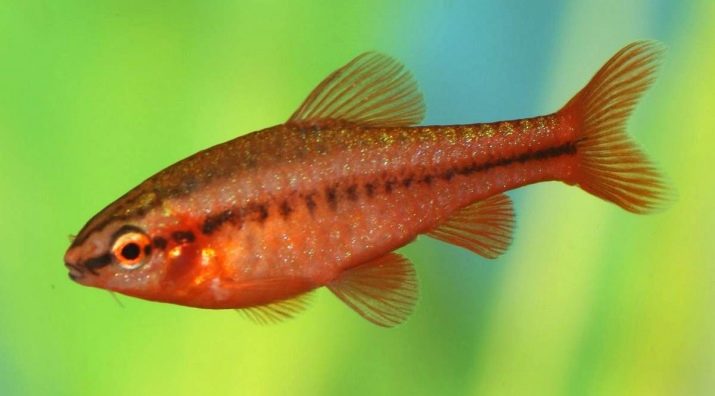
Compatibility
Cherry puntiuses are extremely peaceful creatures, they get along well with almost all aquarium inhabitants. With a species content, it is permissible to place up to 10 individuals in an aquarium of 50 liters. Only the neighborhood with cichlids is considered dangerous, including peaceful ones - scalars, apistograms, when their hunting instinct awakens, compact fish will be threatened.
You should not plant a cherry barb in an aquarium with predators - they will almost 100% destroy the entire population.
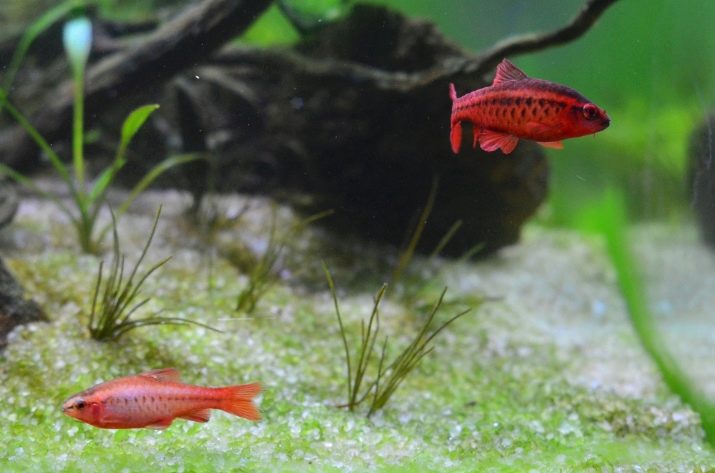
But there are neighbors with whom the puntius gets along well.
- Various types of small crustaceans, including tender shrimp. Their cherry barb does not touch.
- Representatives of the haracin fish family. It includes neon, tetra, thorns.
- Labyrinth - lalius, gourami.
- Pecilia fish. These include guppies, platies, swordtails.
- Small representatives of the carp family... This includes fire barbus and gold, zebrafish, rasbora.
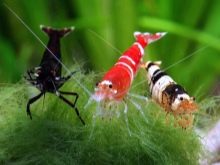
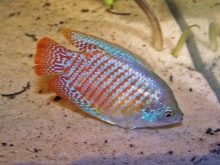
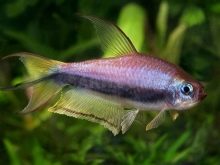
It is very important to select fish with approximately the same level of aggressiveness and size for the aquarium.
This will reduce the possible level of stress and will provide every inhabitant of the underwater world with suitable living conditions.
Growing conditions
It will be easier to create comfortable conditions in the aquarium if the breeder takes into account the individual characteristics of the breed. Cherry barbs at home need careful care and at least 10 liters of volume per individual. An aquarium of 50 liters is enough to shelter a school of 5 fish. It is better to choose the classic shape of the tank in the form of a parallelepiped.
A short and long aquarium without high walls is a good solution to give the barbs the space they need to swim. There should be enough vegetation and decorations inside, you can equip a grotto or place large driftwood at the bottom. Water must be kept in good condition and contamination must be dealt with regularly. Depending on the availability of other inhabitants, it may be necessary to change from 1/3 to 1/5 of the volume of fluid weekly.

Even tap water is suitable for barbs, but it must be clean, filtered, and settled.
Optimum temperature parameters + 22 ... 27 degrees Celsius, you can refuse heating if the room is warm. It is necessary to maintain the pH level in the region of 6.3-7.6, the optimal hardness is 6-18 dH.
Caring for a cherry barb in your home aquarium is also easy. He needs regular feeding, and it is also worth monitoring the health of the pets. To reduce the stressful effects of external factors, it is recommended to use daylight and additional illumination with lamps, dark loose soil, emphasizing the brightness of the fish color.Volcanic sand or dark gravel can be used.
When choosing vegetation for an aquarium, do not skimp on the amount of greenery.
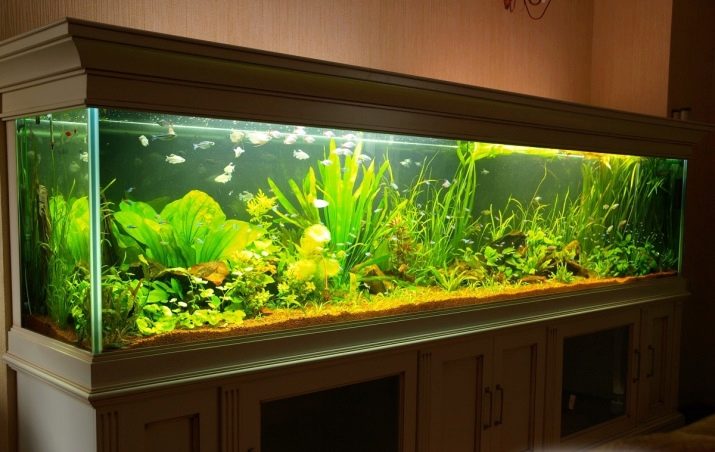
In the natural environment, cherry barbs live practically in thickets, in coastal backwaters, and in a bare reservoir they will feel alarmed.
Ambulia, Bacopa Karolinska, Vallisneria, Hygrophila, Aponogeton are best suited for these fish.
In order for the closed ecosystem of the aquarium to function successfully, you need to equip it with the necessary equipment. A filter and an aerator are required in the tank. Additionally, a pump can be installed to help maintain a cleaner environment, facilitating water circulation.
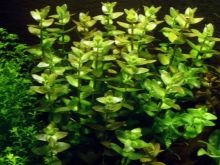
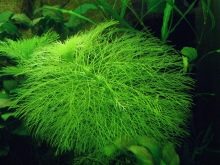

Correct feeding
The optimal diet of cherry barbs is the one that is close to natural. It should contain quite a lot of protein, live food. But in general, these fish, when kept aquarium, are quite omnivorous, they eat dry food - flakes, granules. The share of dry food will be 25-30%, of the herbal supplements, the most useful are dandelion, nettle, spinach, lettuce leaves.
Due to the fish's tendency to overeat, it is imperative to periodically arrange fasting days without feeding at least once a week. The rest of the time, two feedings per day will be enough. The compact size of the puntius, the small mouth, does not allow them to immediately capture a large amount of food. The feed is crushed, or products with the smallest size fractions are selected. Vegetables and leaves are doused with boiling water to destroy the bacterial flora.
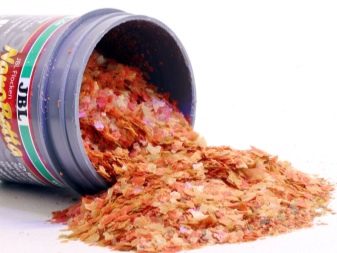
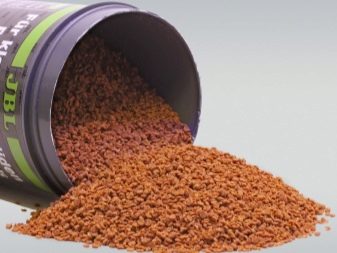
From animal food, you should definitely choose brine shrimp, tubule, bloodworms, thoroughly grinding them beforehand.
You can offer ready-made foods, especially those that enhance the brightness of the color of the fish. It will be useful to include green peas, chopped cucumber or zucchini in the diet. The use of frozen products by fish will also be useful. It is pre-thawed, and only after that it is given to the pets.
After feeding, the remains of food must be removed from the tank, keeping the water clean. If this condition is not met, the environment will acidify, toxic compounds are formed in the aquarium, which are fatal to fish. The optimal serving size is the one that is eaten in 5-7 minutes. Obesity is extremely harmful for barbs and can lead to their death.
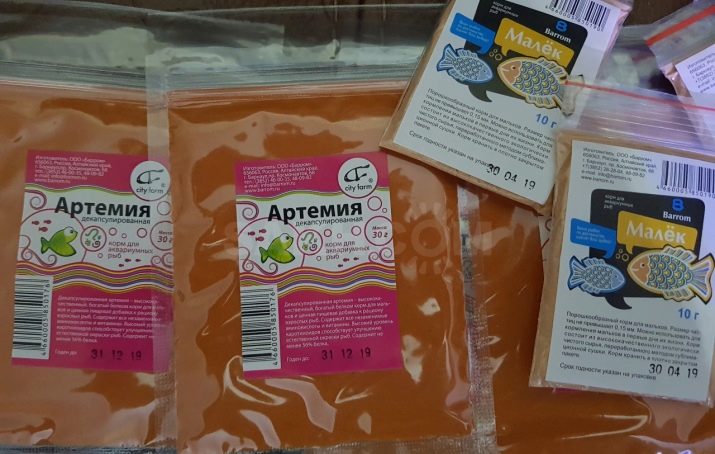
Sex differences and reproduction
The sex difference in cherry barbs is quite clear and distinct, especially during the spawning period. Males at this time acquire that rich color, for which the species got its name. In females, in preparation for spawning, the volume of the abdomen increases significantly. When launching individuals into breeding, it is recommended to transplant into a spawning grounds so that other fish do not destroy the clutch.
Fish demonstrates readiness for reproduction already at 9-12 months.
When keeping, it is recommended to plant at least two males per female. It is possible to induce spawning by raising the temperature in the spawning tank by 1-2 degrees, providing enhanced nutrition with animal feed. The bottom of the spawning aquarium is lined with a special net, plants, Javanese moss should be placed on top. At the end of spawning, adults are removed from the aquarium, the net is removed. Egg fry appear after 2-3 days.
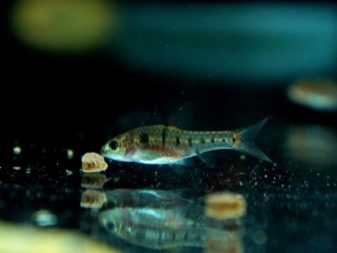

Possible maintenance problems
Consider what problems the cherry barb can deliver to the owner in the content. First of all, atypical behavior of the fish can become a cause for alarm. If she twitches while swimming, moves unevenly, or looks too lethargic, the cause should be looked for as soon as possible.
Among the most obvious problems are stress and poor conditions of detention.
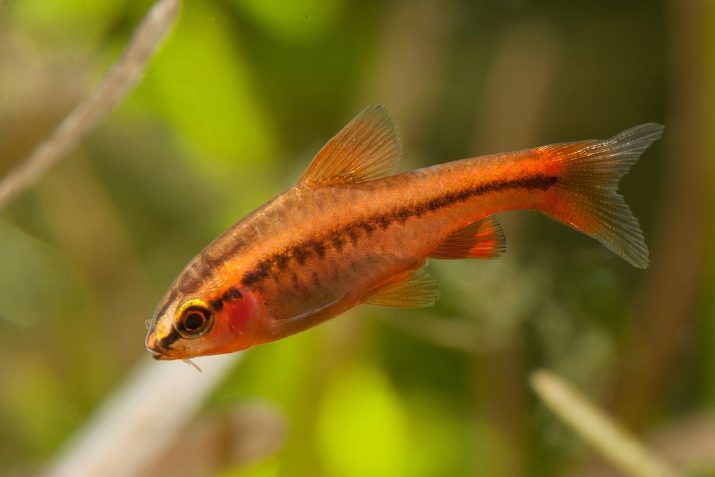
Manifestations of nervousness are usually observed when:
- too high density of the aquarium population;
- the presence of aggressive neighbors;
- solitary confinement;
- insufficient number of plants.
Cherry barbs need the company of their own kind, moreover, being left without a fellow tribesman, they can get sick, exhibit reduced physical activity.
Excessively bright illumination in a reservoir poor in green spaces can also become the cause of nervous trembling. If there is not enough shelter, the fish can become very stressed.
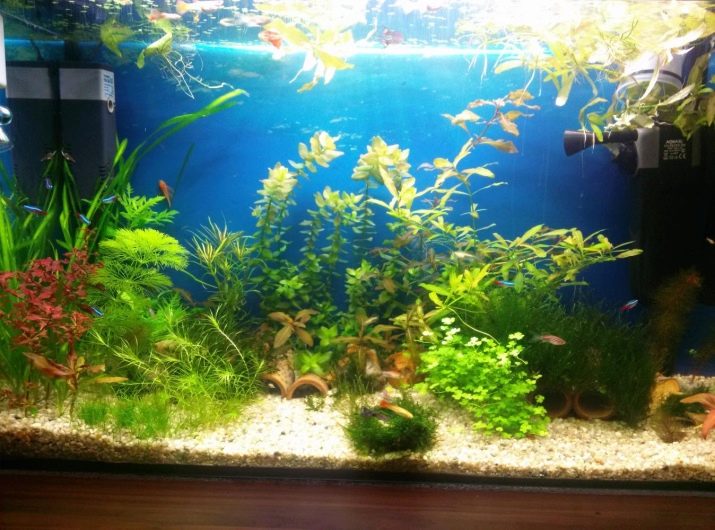
When buying cherry barbs, many aquarists find themselves disappointed with their color. Fish remain faded, do not gain brightness. The problem can be corrected only by good living conditions, abundant and varied nutrition, and the absence of stress factors. It is important to remember that females of this puntius species are initially less brightly colored. Special lines of food help to stimulate the development and color saturation in males.
Barbs are sensitive to the presence of nitrogen and ammonia, to water hardness. If the pet clearly reduces the level of its activity, becomes lethargic, it is worth conducting drip tests of the environment in which it is kept.
There is no need to neglect the rules of care - a water change should occur weekly in at least 1/5 of the total amount of liquid.
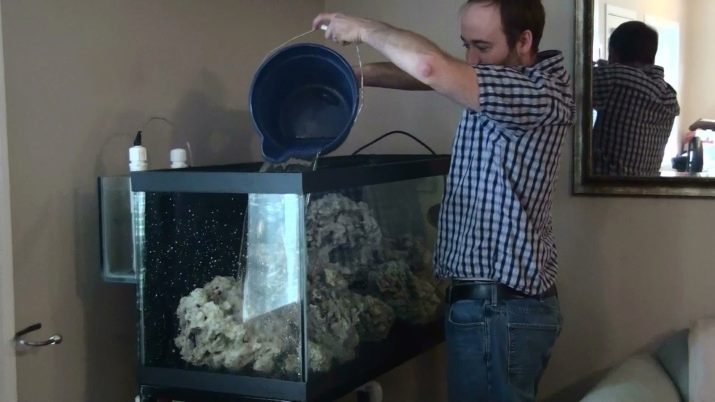
Plant eating is the norm for cherry barbs... This behavior is not indicative of poor feeding. It's just that in nature the fish does the same. To eat it, it is worth planting small-leaved plants, and with the help of specimens with large foliage, create the necessary shade.
For more serious health problems, it is worth taking a closer look at the conditions created for the life of the cherry barbus. If necessary, the fish can be isolated, transferred to a quarantine regime.
For information on how to achieve spawning from a cherry barbus, see below.








